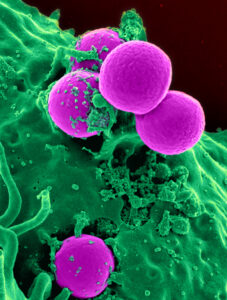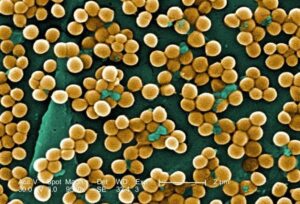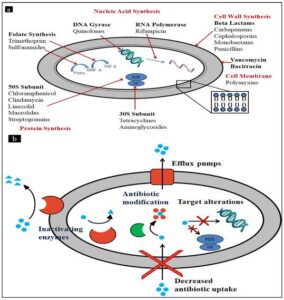Back to: MICROBIOLOGY 300 LEVEL
Welcome to class!
I’m really glad you’re here today. We’re about to discuss a powerful and very relevant topic in modern microbiology—MRSA, MDR-TB, and Bioterrorism Agents. These are not just textbook concepts; they are real public health threats in today’s world, including here in Nigeria. Whether it’s drug-resistant bacteria or deadly microbes being used as weapons, your understanding of these issues will shape how you help protect communities and save lives.
MRSA, MDR-TB, Bioterrorism Agents
MRSA (Methicillin-Resistant Staphylococcus aureus)
MRSA is a type of Staphylococcus aureus that has become resistant to methicillin and many other common antibiotics. Normally, S. aureus lives harmlessly on our skin or in the nose, but when it enters the body through a cut or wound, it can cause serious infections—especially if it’s resistant to treatment.

MRSA infections can appear as:
Boils and abscesses
Wound infections after surgery
Pneumonia or bloodstream infections in hospitalised patients
In Nigerian hospitals, MRSA is becoming more common, especially in poorly sanitised wards. It spreads through contact with infected surfaces or hands. Prevention depends on good hygiene, proper wound care, and limiting unnecessary antibiotic use.
MDR-TB (Multidrug-Resistant Tuberculosis)
MDR-TB is tuberculosis that no longer responds to isoniazid and rifampicin, the two most powerful anti-TB drugs. This happens when TB treatment is not completed properly or the wrong drugs are used.
Imagine someone in Kano who stops taking their TB drugs after two weeks because they feel better. The remaining bacteria mutate and become stronger. When they cough, they spread this resistant strain to others—this is how MDR-TB spreads.

Treating MDR-TB takes longer (often 18–24 months), with more expensive and toxic drugs. That’s why early diagnosis, strict drug adherence, and regular follow-up are so important.
Bioterrorism Agents
Bioterrorism involves the deliberate release of harmful biological agents—bacteria, viruses, or toxins—intended to cause illness, fear, or death. Some of the most dangerous bioterrorism agents include:
Bacillus anthracis (causes anthrax)
Yersinia pestis (causes plague)
Clostridium botulinum toxin (causes botulism)
Variola virus (causes smallpox)
These agents are often chosen because they’re highly infectious, deadly, and easy to spread. While bioterrorism is rare, governments and healthcare systems must be prepared with surveillance systems, vaccines, emergency response plans, and trained public health teams.
Why is this important for Nigeria?
MRSA is rising in hospitals and clinics.

MDR-TB threatens TB control in urban and rural areas alike.
Though bioterrorism is not common here, global travel and insecurity mean we must be prepared.
Summary
- MRSA is a drug-resistant Staphylococcus aureus that causes serious infections and spreads easily in healthcare settings.
- MDR-TB is a form of TB that does not respond to standard drugs due to misuse or poor adherence.
- Bioterrorism agents are deadly microbes used intentionally to cause harm and fear.
- Prevention relies on hygiene, responsible antibiotic use, and strong public health systems.
Evaluation
- What does MRSA stand for and why is it dangerous?
- How does MDR-TB develop?
- Name two microbes that can be used as bioterrorism agents.
By learning this topic, you’re becoming a defender of public health. Whether you’re preventing drug resistance or responding to outbreaks, your knowledge is a powerful tool. Keep showing up, stay curious, and remember—Afrilearn is here to walk this journey with you. On to the next class!
